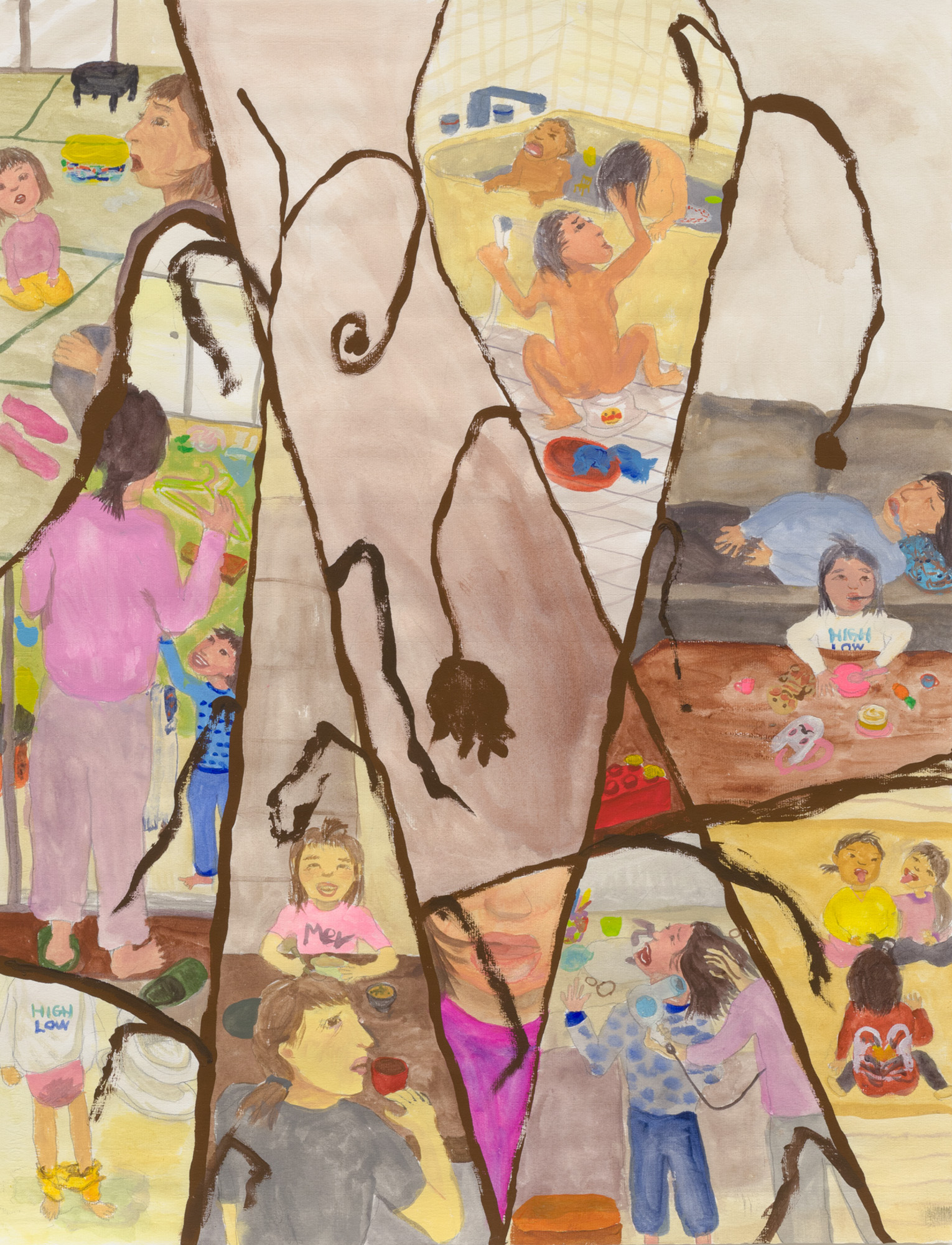“I want to wear a warm sweater.”
By Hyunjee Nicole Kim

Installation view of KYOKO IDETSU’s I want to wear a warm sweater., 2022, oil on canvas, 193.99 x 129.86 cm, at "I want to wear a warm sweater.," Bridget Donahue, New York, 2022. Photo by Gregory Carideo. All images courtesy the artist and Bridget Donahue.
Prior to visiting Kyoko Idetsu’s solo exhibition, “I want to wear a warm sweater.” at Bridget Donahue, New York, I peeked at the checklist posted on the gallery’s website. Accompanying the usual thumbnail images and tombstone captions were brief notes—written and translated from Japanese to English by the artist—about what was depicted in most of the canvases and works on paper on view. The effect of Idetsu’s pithy language was neither particularly poetic nor precious—certainly additive but still a bit surprising, given how straightforwardly and earnestly she shared her thoughts on the subject of the exhibited paintings and works on paper.
Upon entering the gallery, I noticed that portions of the checklist notes were inscribed in English and Japanese onto the walls by a handful of the paintings, including the eponymous I want to wear a warm sweater. (2022), a peculiar portrait of a person wearing a large white knit turtleneck, pulled up past her chin. Set in a forest clearing of sorts—the figure stands among the trees as a stream of water pours forth from a bamboo spout in the top right register—another scene is depicted discretely within her sweater: a child stands on a green mosaic carpet staring at a television screen. This living room setting mimics the domestic confines of the suburban home in Tokyo where Idetsu resides and works. Raising two children, ages six and nine, the artist makes her studio where she can.

KYOKO IDETSU, Man’s Quest, 2022, oil on canvas, 161.93 × 129.86 cm. Photo by Pierre Le Hors.
Gleaned primarily from what Idetsu observes and experiences in daily life, and occasionally from what she reads, the subject matter of the scenes throughout the exhibition are depicted with immediacy. Idetsu’s handling of paint seems fast and loose—quick brushstrokes define recognizable patterns and bodies, and judicious lines create wide-ranging facial expressions that register frustration, weariness, and joy. Moments are tiled upon each other in quick succession: in Man’s Quest (2022), Idetsu pictures a man drinking as he recommends a novelist’s essay on world fishing travelogues—his doubling head captured in motion—and two large silvery fishes poke their heads into the composition from the right. In Park Security (2022), the silhouette of a dark crow is placed front and center, layered above the profiles of two shouting mothers who are trying to shoo the scavenging birds away.

KYOKO IDETSU, Job relocation, 2022, oil on canvas, 129.86 × 240.03 cm. Photo by Pierre Le Hors.
Idetsu forgoes linear perspectives, and the painted scenes can take on a cinematic or comic-like effect, appearing as a loose film strip or pages from a manga. The compositions of works on paper such as 世 (2021), Dying plants, and Reward (報酬) (both 2017), feature thickly applied dividers that appear like stained-glass window panes. She also arranges paintings as unconventional polyptychs at times, spreading out and breaking up compositional elements across multiple panels. Job relocation (2022) shows a story about a family’s sudden move that was prompted by the husband’s company. A long bicycle traverses the three canvases; in the background, three purple arrows variously point to the lined face of an elder, a tree outside of a home, and two people having a conversation.

KYOKO IDETSU, Dying plants, 2017, acrylic on paper, 65.09 × 49.85 cm. Photo by Pierre Le Hors.
Her works can also veer into surrealist, apocalyptic territories in a way that brings us back to the realities of our present situation, perhaps suggesting how we forge ahead in times of great upheaval. In SEAT (2022), the artist takes inspiration from City of Corpses (1948), a memoir that Yoko Ota wrote about surviving the atomic bombing of Hiroshima. The artist pictures a mother, looking fatigued, with her two children, staring across a landscape of myriad figures. Some, seemingly exposed to radiation, have skin melting off—a direct reference to the author’s remembrances—while others, are dressed as if going out for a walk or shopping.
In an odd way, I was reminded of Post-Partum Document (1973–79), the six-year project by American artist Mary Kelly that culminated in a visual analysis of the objects and moments that constituted the rearing of her first child. Idetsu’s paintings were made between 2017 and 2023, many during the Covid-19 pandemic, and they seem to represent the chaotic warmth and unrewarded hardships of performing socially reproductive labor. She unsentimentally illustrates these endeavors as experienced across multiple generations—the pandemonium of potty training, the care of sick relatives, and the burial of one’s family members—in addition to other quotidian moments that relate us to one another universally and across time.

KYOKO IDETSU, SEAT, 2022, acrylic on paper, 101.60 × 152.40 cm. Photo by Pierre Le Hors.
Kyoko Idetsu’s “I want to wear a warm sweater.” was on view at Bridget Donahue, New York, from December 8 to February 4, 2023.

%20x%20200%20(H).jpg)





